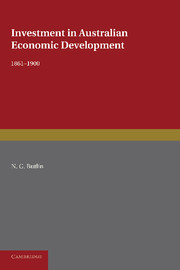Book contents
- Frontmatter
- Contents
- LIST OF TABLES
- LIST OF TEXT-FIGURES
- LIST OF PLATES
- Preface
- PART A INTRODUCTION
- PART B THE PRIVATE SECTOR
- CHAPTER II INVESTMENT IN RURAL DEVELOPMENT
- CHAPTER III INVESTMENT IN URBANISATION I: URBANISATION AND INDUSTRIAL DEVELOPMENT
- CHAPTER IV INVESTMENT IN URBANISATION II: THE GROWTH OF RESIDENTIAL REAL ESTATE
- PART C THE PUBLIC SECTOR
- PART D STRUCTURAL READJUSTMENT
- Appendix I Revision of N.S.W. Residential Investment 1905/06-1911/12
- Appendix II Australian Domestic Product, Investment and Foreign Borrowing, 1861-1938/39.
- Bibliography
- Index
CHAPTER IV - INVESTMENT IN URBANISATION II: THE GROWTH OF RESIDENTIAL REAL ESTATE
from PART B - THE PRIVATE SECTOR
Published online by Cambridge University Press: 05 June 2016
- Frontmatter
- Contents
- LIST OF TABLES
- LIST OF TEXT-FIGURES
- LIST OF PLATES
- Preface
- PART A INTRODUCTION
- PART B THE PRIVATE SECTOR
- CHAPTER II INVESTMENT IN RURAL DEVELOPMENT
- CHAPTER III INVESTMENT IN URBANISATION I: URBANISATION AND INDUSTRIAL DEVELOPMENT
- CHAPTER IV INVESTMENT IN URBANISATION II: THE GROWTH OF RESIDENTIAL REAL ESTATE
- PART C THE PUBLIC SECTOR
- PART D STRUCTURAL READJUSTMENT
- Appendix I Revision of N.S.W. Residential Investment 1905/06-1911/12
- Appendix II Australian Domestic Product, Investment and Foreign Borrowing, 1861-1938/39.
- Bibliography
- Index
Summary
THE IMPORTANCE OF RESIDENTIAL INVESTMENT
Substantial as the physical assets of the pastoral industry were, the weight of the private capital requirements of the expanding Australian economy is, perhaps, shown most vividly in the absorption of resources in growing residential capacity. Housing represented, at once, a heavy drain on Australian resources and a powerful stimulus to industrial, commercial and financial growth. Residential investment, under sustained boom conditions and boosted by speculative pressures, was the leading field of investment throughout the second half of the nineteenth century, rivalled only by pastoral capital formation during the brief period 1874-81. Except for a few years between 1860 and 1890, gross residential investment accounted for rather more than one-third of total (public and private) capital formation in Australia and absorbed between 3 and 7 % of gross domestic product. For Australia as a whole, dwelling space continued to grow rapidly until 1888. An intense housing shortage in 1861, due to the influx of population during the 'fifties, a high, though variable, inflow of migrants from overseas in the years after 1860, sustained high employment and high wage-rates, relatively stable building costs which remained quite low in relation to wage incomes, high, but gradually falling rents, and increasingly easy credit conditions: these were the circumstances which surrounded a sustained building boom which began in the 'fifties and, in the aggregate, continued until the end of the 'eighties.
The simultaneous drain on resources and stimulus to growth affected several sections of the economy. The sustained demand for residential facilities transformed the methods and business organisation of the building industry, changing rapidly from owner-building to small-scale contract construction and eventually to large-scale speculative building operations. It encouraged also a large-scale expansion in the output of commercially produced building materials, in place of the primitive materials of the 'fifties; and there was a closely linked change in the business organisation for importing and processing building materials. Perhaps the most profound contribution to institutional change lay in the encouragement of local domestic saving. Housing was the one major sector in which finance was dominated by local savings (indirectly enlarged by foreign funds) and for which local Australian resources were marshalled.
- Type
- Chapter
- Information
- Investment in Australian Economic Development, 1861–1900 , pp. 211 - 288Publisher: Cambridge University PressPrint publication year: 2013



